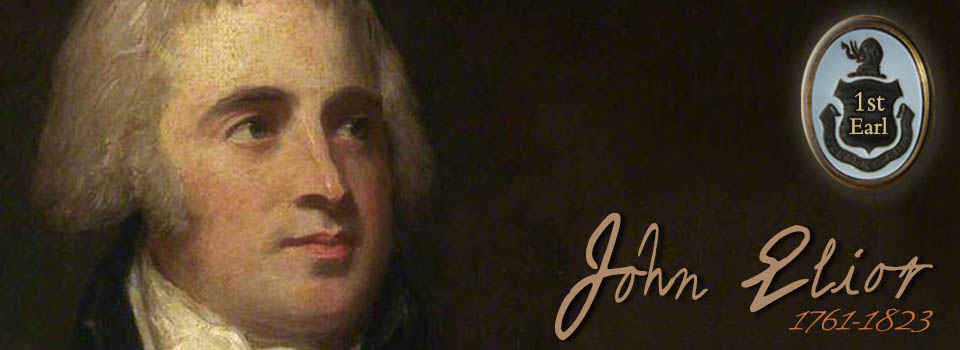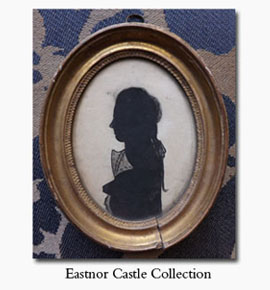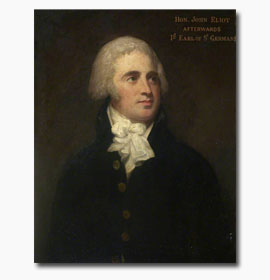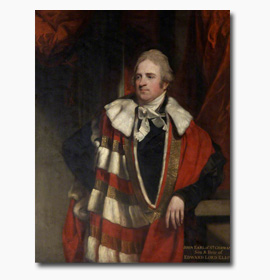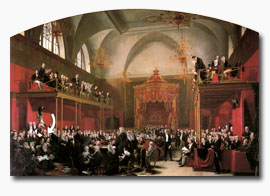John Eliot, 1st Earl of St. Germans (1761 - 1823)
John was the third child and third son of Edward Eliot and Catherine Elliston.
John Eliot was born at Port Eliot on the twenty-eighth day of September in 1761 and was baptised just eight days later at St. Germans. His childhood was passed at Port Eliot with probable trips to London. He followed in the footsteps of his older brother, Edward James, and was educated at Liskeard School before entering Pembroke College, Cambridge, on 6 Apr 1780. Four years later, he was awarded his M.A at Cambridge, as well as becoming M.P. for Liskeard (the family's pocket borough). He occupied this seat until his father's death in 1804.
In conjunction with his studies and political career, John was called to the bar at the Inner Temple on the tenth day of February 1786 (coincidentally, the very same day that James Boswell, renowned author and acquaintance of the Eliot family, was also called to the bar). John was recommended to the Inner Temple by Mr. Samuel Salt, a Bencher of the Inn and the family lawyer. He was nominated on the third of May in 1788 as a Reader of Clifford's Inn (one of the Inns of Chancery and a preparatory school for the Inns of Court), though there is no indication that he was actually ever appointed to the post. No doubt, given the actual work and study time required, this was more of a relief than a disappointment. The only other record that survives regarding John's actions at the Inns of Court is a Bench Table order (dated 20 Jun 1800) ordering Eliot's Bar Bond (money owed to the Bar in return for John being called) to be "delivered up upon paying his duties to the house." As there are no other records relating to this incident, it is possible that the Bar Bond was never paid. John Eliot's legal career seems to have been a short one, as the only reference to it is a leave of absence at the end February 1793, granted by the House of Commons, in order for him to practice as a Barrister on the Western Circuit. In 1798, John was made a Justice of the Peace for Cornwall, a position which was as much administrative work as judicial in those days and did not require the work of a practicing barrister.
Very little is actually preserved about the individual characteristics of the first Earl of St. Germans. In later years, he was described by Lord Minto as "a fattish, fairish, silent kind of gentleman". John did not care to write letters, a fact well substantiated by the fact that no extant letters written by him can be found in the Port Eliot collection. His handwriting was so poor that the architect John Soane actually kept a clerk to transcribe Eliot's illegible correspondence to him before Soane would look at it. In 1803, John appears on the military lists as the Captain of the Cornwall Yeomanry and Lieutenant-Colonel Commandant of the East Cornwall Volunteers. Five years later, he was promoted to the rank of Colonel in the East Cornwall Militia.
Throughout his political career, John Eliot was a staunch Pitt supporter. He voted for parliamentary reform, Pitt's income tax proposals, and the abolition of the slave trade but against the repeal of the Test Act in Scotland. He is recorded as having made some speeches in the House, though none important or particularly noteworthy.
After Pitt's death in 1806, John (by now Lord Eliot, having succeeded to his father's title in 1804) continued in his support of Pitt's goals and political friends, putting him at odds with Lord Grenville, the new Prime Minister, and resulting in harassment of Eliot's Cornish boroughs. When a new administration came to power (Lord Liverpool, another friend and supporter of William Pitt), John was once again able to show governmental support by returning friends of the new Prime Minister in all of the Eliot seats. In return for this loyal support, the P.M. recommended John for a peerage. Lord Eliot thanked his friend, saying that he had "long had a desire for some mark of royal and public favour and approbation", and further stating that "I am indeed proud of my connection with Mr Pitt, but still more proud of having made him my guide in public." On 28 Nov 1815, John Eliot was made a Peer of the Realm and created Earl of St. Germans. Since his father's death, John had assumed the surname and the arms of Craggs (as Craggs-Eliot), but he discontinued the use of this name after receiving his earldom (though he continued to quarter his arms with those of Craggs).
John Eliot was very active in the buying and selling of Real Estate throughout his adult life, allowing him to make substantial upgrades and changes to the family estates at Port Eliot and Blackheath. Beginning in 1790, and continuing for the remainder of his life, John worked with the renowned architect, Sir John Soane, on various London properties. Ultimately, they accomplished one of the major renovations at Port Eliot, the results of which are still visible today. It is to the first Earl's work (and that of his father, Edward, first Lord Eliot) that the Eliot family through the centuries has owed the larger portion of their physical and financial comfort. While there may not be much left to remind us of John Eliot's personal life, he certainly left his mark on the estate.
On 17 Nov 1823, shortly after his 62nd birthday, John Eliot died at Port Eliot, the home which he so dearly loved. The local newspaper reported that "His Lordship's illness was a paralytic seizure and was of very short continuance." Ten days later, he was buried with his first wife in the "new" Eliot family vault, just a short distance down the road from Port Eliot. A disintegrating stone plaque on the top of the vault marks John's final resting place, but a beautiful marble wall monument was erected to John's memory by his second wife in the church of St. German's. Its long and sorrowful inscription reads as follows:
Near This Place
Are Deposited the Remains of
John, First Earl of St. Germans
Who Was Born
On the 28th of September 1761,
and Died on the 17th of November 1823.
He Married First
Caroline, Only Daughter
of the Right Honourable
Charles Yorke,
Lord High Chancellor
of Great Britain.
Secondly, Harriet,
Fourth Daughter
of the Right Honourable
Reginald Pole Carew,
But Left No Issue
To Keep Alive the
Memory of a Truly Just
and Liberal Man
Whose Heart Teemed with
Kindness and Benevolence.
This Stone
Is Placed Here
Who Most Tenderly Loved
And Who is Left Alas
Most Deeply to Lament
His Loss.
Let Patience Sooth, Not Cure the Sacred Grief,
Which Prays Not for Oblivion, but Relief.
Oblivion! No --- To Life's Extremest Bourn
All, Who Have Loved and Lost Thee Still Mourn.
MARRIAGES
John Eliot was married twice, both times without issue. His first wife was Caroline, daughter of Charles Yorke, Lord Chancellor of Britain. They were married at St. George's, Hanover Square in London, on 09 Sep 1790. Their marriage, apparently a very happy one, lasted until her untimely death in 1818. They circulated in the highest of London society, and their names appear often in the society columns of the early eighteenth century, often hosting grand balls, dinners and "routs".
John Eliot's second wife was Harriet Pole-Carew, the daughter of Reginald Pole-Carew of Antony House (near Port Eliot in Cornwall). Her mother, Jemima Yorke, was actually the first cousin of John's first wife, Caroline. John Eliot and Harriet were married at Antony in Cornwall on 19 Aug 1819, but the marriage was short, John dying just four years later.
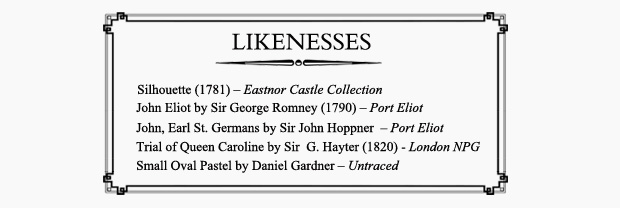
John Eliot was painted in 1820 by Sir George Hayter as one of the many gentlemen in his group portrait of "The Trial of Queen Caroline". There are three known individual portraits of John: one small oval pastel, one 1790 oil by George Romney, and a later oil by J. Hoppner showing John as Earl of St. Germans in his court robes. A small, framed silhouette of John from 1781 is part of the Eastnor Castle Collection.
